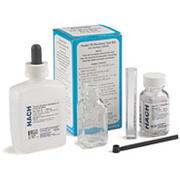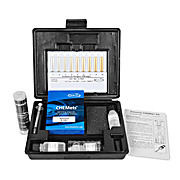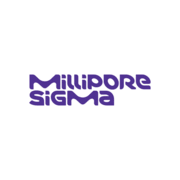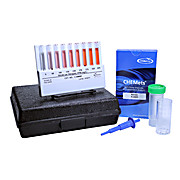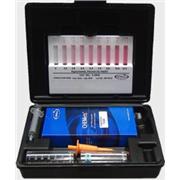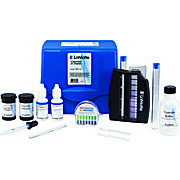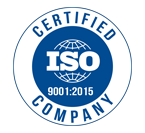Portable Water Quality Test Kits
They are invaluable when measuring the pH levels of water, which measures the acidity and alkalinity of the water and is important for assessing if water is suitable for drinking, agricultural, or industrial processes. Monitor the chlorine levels to ensure all water is disinfected correctly and safe for consumption.
Some water quality test kits can also identify the presence of harmful bacteria, which are indicators of water contamination and potential health risks.
Portable water testing kits are available in multiple forms, including test strips, chemical reagent kits, and more. Suitable for different types of water sources, including drinking water, pool, or environmental monitoring applications.
-
Water hardness is caused almost entirely by calcium and magnesium ions. Other di- and trizalent metals have a similar effect, but usually are not present in high enough concentration in potable waters to cause problems. Hardness increases soap consumption in laundries and causes scale in boilers. …
-
Come in a 60 mL quantity, this performance check standard is for inspection and monitoring water quality.
-
 Chlorine Test Kits
LaMotte
Chlorine Test Kits
LaMotteDPD Tablet Octa-Slide (9859G42) Sufficient for 50 tests Employs DPD tablet method: EPA- accepted method for NPDWR Octa-Slide has color standards representing 0.2, 0.4, 0.6, 0.8, 1.0, 1.5, 2.0 and 3.0 ppm Cl Low Range Octet Comparator (9859H10) Employs DPD tablet…
-
Cadmium Test Kit
LaMotteOctet Comparator Method For determining cadmium in water using Dithizone method; commonly occurs from the deterioration of galvanized pipe Octet comparator has color standards representing 0.1, 0.2, 0.3, 0.4, 0.5, 0.6, 0.8 and 1.0 ppm cadmium. For use only where organic matter is absent and…
-
Ammonia HBA Test Kit
CHEMetricsLow-level ammonia nitrogen may be naturally present in water as a result of the biological decay of plant and animal matter. Higher concentrations in surface waters can indicate contamination from waste treatment facilities, raw sewage, industrial effluents (particularly from petroleum refineries),…
-
Sulfide CHEMets® Kits
CHEMetricsSulfides are naturally present in ground waters as a result of leaching from sulfur-containing mineral deposits. Surface waters do not usually contain high sulfide concentrations. Sulfides result from the decomposition of organic matter, from bacterial sulfate reduction under anaerobic conditions…
-
Formaldehyde CHEMets Kit
CHEMetricsFormaldehyde, a toxic substance, is used in the following applications: metal plating baths, textile treatments, biological specimen preservatives, and disinfectants of medical equipment. Commercial formaldehyde gas is readily soluble in water. The Purpald Method Reference:…
-
Phosphate Vacu-vials® Kits
CHEMetricsPhosphorus occurs naturally in rock formations in the earth's crust, usually as phosphate. High phosphate concentrations in surface waters may indicate fertilizer runoff, domestic waste discharge, or the presence of industrial effluents or detergents. Although phosphates from these sources are…
-
Nitrate/Nitrite Test Kit
LaMotteApplications: Food and Beverage, Environmental Education, Industrial Water Boiling and Cooling, Laundry and Sanitation, Water and Wastewater This kit tests for nitrate or nitrite using the Octa-Slide 2 Comparator. Range/sensitivity is 0.25, 0.5, 1.0, 2.0, 4.0, 6.0, 8.0, 10.0 ppm…
-
Low-level ammonia nitrogen may be naturally present in water as a result of the biological decay of plant and animal matter. Higher concentrations in surface waters can indicate contamination from waste treatment facilities, raw sewage, industrial effluents (particularly from petroleum refineries),…
-
NITRATE NITROGEN REFILL KIT
LaMotteThis kit tests for Nitrate in water using reagents to form a pink color. Results are determined using the Octa-Slide 2 Comparator Range/sensitivity is 0.25, 0.5, 1.0, 2.0, 4.0, 6.0, 8.0, 10.0 ppm NO3 - -N
-
Sulfide Vacu-vials® Kits
CHEMetricsSulfides are naturally present in ground waters as a result of leaching from sulfur-containing mineral deposits. Surface waters do not usually contain high sulfide concentrations. Sulfides result from the decomposition of organic matter, from bacterial sulfate reduction under anaerobic conditions…
-
-
The LaMotte Stormwater MS4 Kit has instrumentation and reagent systems to provide a preliminary screening of stormwater outflow, and to determine whether it is contributing to the overall pollutant load from precipitation events. Meets guidance as set forth by USEPA. Features …
-
Nitrate CHEMets Kit, Range: 0-675 ppm
CHEMetricsNitrate is the most completely oxidized form of nitrogen. It is formed during the final stages of biological decomposition, either in wastewater treatment facilities or in natural water supplies. Low-level nitrate concentrations may be present in natural waters. However, a Maximum Contaminant Level…
-
Spectroquant ® Prove 300: a robust UV/VIS spectrophotometer for sensitive measurements, such as the analysis of drinking water and beverages.
-
Iron is present in nature in the form of its oxides, or in combination with silicon or sulfur. The soluble iron content of surface waters rarely exceeds 1 mg/L, while ground waters often contain higher concentrations. The National Secondary Drinking Water Standard for iron is 0.3 mg/L, as iron…
-
 Arium Consumables & Accessories
Sartorius
Arium Consumables & Accessories
SartoriusConsumables & accessories for Sartorius Arium laboratory water systems. Arium® Smart Station flexible remote dispenser Ultrapure Water for benchtop or wall-mounted installation. The Arium® Smart Station is designed for flexible remote dispensing of ultrapure water directly at the…
-
Molybdate CHEMets Kit, Range: 2-24 ppm
CHEMetricsMolybdate is used throughout the industrial water treatment and power generation industries as a corrosion inhibitor in both open- and closed-loop cooling water systems. In solution, molybdate anions complex with oxidized iron to form a protective film of molybdate and ferric-oxide. Molybdate is…
-
Ammonia HBA Test Kit
CHEMetricsLow-level ammonia nitrogen may be naturally present in water as a result of the biological decay of plant and animal matter. Higher concentrations in surface waters can indicate contamination from waste treatment facilities, raw sewage, industrial effluents (particularly from petroleum refineries),…
-
Hydrogen peroxide is a strong oxidizing agent with a variety of uses. Applications include the treating of industrial effluents and domestic waste and serving as a disinfectant in aseptic packaging. For the food and beverage industry, CHEMetrics Hydrogen Peroxide CHEMets® and…
-
AquaComparator Test Kit Line
LovibondLow Cost, Easy to use kits for testing a wide range of water quality Parameters Continuous gradient color disks provide accurate measurements—no need to “extrapolate” between discrete color blocks Rotate the color wheel to obtain a color match with the reacted sample and read your result…
-
No color matching, no look up charts, no guessing! The unique, multi-test ColorQ pool and spa hand-held photometer reads SEVEN test factors (Free Chlorine, Total Chlorine, Bromine, pH, Alkalinity, Calcium Hardness, and Cyanuric Acid) directly on a digital display. Featuring an innovative…
-
Because of its strong oxidizing properties, chlorine is an excellent biocide used to treat potable waters, municipal wastes, and swimming pools. When used to treat potable water, chlorine helps alleviate the adverse effects of iron, manganese, ammonia, and sulfide. The Maximum Residual Disinfectant…
-
Cyanide Test Kit
LaMotteOctet Comparator For determining trace levels of free cyanide in water Octet comparator has color standards representing 0.00, 0.10, 0.15, 0.20, 0.25, 0.30, 0.35 and 0.40 ppm Free CN - Sufficient for 50 tests
-
Kit Contains: 100 Chlorine DPD #1 Tablets 50 Phenol Red Tablets 3 Test Tubes, 2.5, 5, 10 mL, plastic w/ caps 1 Chlorine/Bromine Octa-Slide 2 Bar 1 Phenol Red Octa-Slide 2 Bar, pH 6.8-8.2 1 Octa-Slide 2 Viewer
-
The Lovibond® calcium hardness calcio no. 1/no. 2 tablet set is suitable for use in research facilities and chemical laboratories to conduct wide range of experiments. It is available in sturdy bottle that endures heavy and rigorous usage. It contains 100 tablets.
-
Alkalinity Test Kit
LaMotteApplications: Drinking Water, Industrial Water Boiling and Cooling, Water and Wastewater This Alkalinity Test Kits uses a Direct Reading Titrator with standard acid to the phenolphthalein (P) and/or total (T) alkalinity endpoint. Range and sensitivity is 0–200 ppm as CaCO3 in 4 ppm…
-
Chlorine Test Kit
LaMotteThis Chlorine test kit measures for Chlorine using the direct reading titrator method. Range/sensitivity is 0-10 ppm/0.2 ppm Cl. Applications: Drinking Water, Food and Beverage, Industrial Water Boiling and Cooling, Laundry and Sanitation, Water and Wastewater # Tests (# Rgts): 50 at 10…
-
 Color of Water Sets
Lovibond
Color of Water Sets
LovibondA method for measuring the color of potable water in terms of an easily reproducible color standard is essential to water engineers responsible for the distribution of supplies for public consumption. Color determinations are useful for detecting any irregular contamination of the supply due…
-
UN Number: UN3316
-



